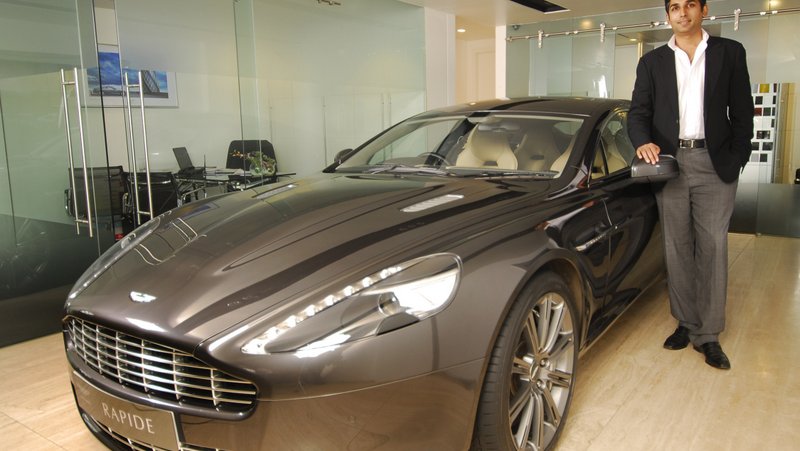Lalit Choudary, Managing Director of Infinity Cars Private, offers his insights on the Indian consumer, entering the Indian market and the most effective channels for local communication

Lalit Choudary, Managing Director of Infinity Cars Private, offers his insights on the Indian consumer, entering the Indian market and the most effective channels for local communication
Lalit Choudary, Managing Director of Infinity Cars Private, offers his insights on the Indian consumer, entering the Indian market and the most effective channels for local communication.
“It felt like it was the right time to bring Aston Martin into the Indian luxury car market,” explains Lalit Choudary, Managing Director of Infinity Cars Private, the official dealership of Aston Martin in Mumbai and dealers of BMW cars in Mumbai, and Indore, India. “Different luxury brands were gradually appearing across a variety of locations in India and doing extremely well. It felt like the right time for Aston Martin to be brought in, given the strong interest in the luxury car market in India.”
Automotive interests were not always paramount to Mr. Choudary. A graduate of IIM Calcutta, he initially worked as an Investment Banker at Lehman Brothers for 8 years, spending the most of his time in Hong Kong. It was only after relocating to India in 2006 to establish an Indian operation for the famed bank that he identified a growing opportunity in the luxury goods segment, complimenting the rapid rise in domestic wealth.
“ It felt like the right time for Aston Martin to be brought in, given the strong interest in the luxury car market in India ”
The same year Infinity Cars Private Limited was established with a BMW dealership in Mumbai, followed by a location in Madhya Pradesh State. In 2009 the business assumed distribution for LVMH’s Princess Yachts in the region, followed by discussions with Aston Martin to bring the brand to Indian shores. After just one year, the Indian outpost achieved its objective of retailing 30 cars from a range of various models, such as the Vantage, Rapide, DB9 and DBS.
With India set to become a staggering $14.7 billion luxury market by 2015 the future looks bright, yet regulations, taxes and politics continue to hamper the development of local retail. We sat down with Mr. Choudary to get his insights on the Indian consumer, entering the challenging Indian market and the most effective channels for local communication.
Current FDI legislation prevents foreign brands opening directly owned retail stores, unless they produce a certain percentage of their products in India. Alternatively they can launch a joint venture, as I assume you have with Aston Martin.
India offers a complex but evolving regulatory environment, which could allow for potential change within the future. The direction of reform is cast but the speed and the intermittent reversals are a cause for frustration, a frustration that is relevant to our clients that are keen motorists.
Having said this, this may be something that is unavoidable as India is a mix of social and economic classes. It is therefore so important to take into account that often interests of various strata have to be protected. Duties play a big role in the impact of luxury consumption in India and with time it is potentially likely to ease. Consumption is likely to increase to global benchmarks but this will take time, from 5-10 years I would say.
“ Duties play a big role in the impact of luxury consumption in India and with time it is likely to ease. Consumption is likely to increase in 5-10 years time ”
How would you describe the current local luxury market in India? And specifically, how would you categorise the health of the luxury auto market?
The current local luxury market in India is very good. India has seen a continuing increase in both consumerism and awareness in the Indian luxury market thus influencing and determining its very strong positioning over the last few years.
Having said this however, the want for luxury goods still remains very niche in India. This niche status can be accountable for by the high pricing of goods, even when compared to elsewhere in the world. With time, one hopes taxes will come down and make pricing more comparable to other markets, which will induce high growth in the luxury segment.
What are some key characteristics of the Indian luxury consumer?
The typical Indian luxury consumers are young businessmen who have been exposed to luxury brands through their overseas travel, education or gifting. Our buyers are typically men often ranging between their late thirties and early forties with children in their late teens, these children are also said to enjoy their father’s car. Other Indian luxury consumers span a variety of ages, some being in their early 20’s and others in their late 60’s/70’s, these individuals often buy the cars merely for the thrill of owning them.
“ The typical Indian luxury consumers are young businessmen who have been exposed to luxury brands through overseas travel, education or gifting ”
What are some key customer segments in your market?
The majority of individuals buying into the Aston Martin brand at the moment are generally male entrepreneurs aged between 35 and 45. Indians across all major cities are beginning to take to and buy into the luxury market.
Delhi and Mumbai often set the trend, but quickly enough one sees significant consumption from cities such as Bangalore, Hyderabad, Pune, Chennai and Chandigarh. Across time these cities set trends in their local geographies that encourages consumption creeping into the tier II cities.
How do the local characteristics of your market impact range selection and marketing? Are there characteristically Indian tastes when it comes to luxury automobiles?
For the search of the sedan vehicle Indian customers prefer comfortable back seats and soft handling, but when it comes to the pursuit of sports cars Indian customers are typically understated. Indian customers think through the usage of the car and prefer practicality for their vehicle.
Things such as four doors functionality of the Rapide and relatively high ground clearance of the Aston Martin range allow for the cars to be driven on any city road across big speed bumps. Indian customers are often widely travelled and are fascinated by the British legacy of the Bond association with Aston Martin, this ultra-exclusivity of the cars super cool image helps to continually build brand demand.
“ Delhi and Mumbai often set the trend, but one sees significant consumption from Bangalore, Hyderabad, Pune, Chennai & Chandigarh ”
What are the most effective channels of communication in India?
India’s luxury markets most effective channel of communication is primarily positive word of mouth, however there is no denying the strong influence in which the media has in effecting the consumers habits. Media’s such as lifestyle publications, television and the Internet all play huge roles in the communication with consumers in India.
As mentioned previously in regards to customer segments in the market a key channel of communication would be the wanting to copy and follow emerging trends. Over time the copying of emerging trends by a small number of cities snowballs across the country thus influencing what the majority is consuming.
What are the most significant trends you believe will influence your local market in the future?
A favourable macro-economy is important as that engenders a good-feel among the consumer segments. The continued integration of India into the global economy is important as global brands will gain greater recognition and desirability among Indians.
Duties imposed on luxury cars will need to be stable or better still brought down, as they are already way too high. Improved local driving conditions especially with respect to in-city roads and expressways will influence the consumption into the India’s local market.
Finally, are there any key insights commonly overlooked when it comes to discussing the luxury market in India? Or specific observations you have made?
The market for luxury in India is still in its nascence. In many product categories such as fashion accessories, watches and hotels the consumption often happens offshore. It is therefore important for businesses in luxury to offer an experience similar to elsewhere in the world on several key parameters. These parameters include factors such as ease of access, quality of retail space, trained in store staff and value for money offering where the overall experience justifies the amount charged.
Taking from and ensuring the inclusion of all of these factors would help win back offshore consumption among Indians. Further to all of this, I believe as local consumption increases more people will jump into the consumption class, which will propel an increase in the penetration of luxury goods in the local markets.
To further investigate the Indian luxury market on Luxury Society, we invite you to explore the related materials as follows:
– Challenges Remain for Luxury Brands in India
– Luxury Society Market Guides: Brazil, Russia, India & China
– A New Wave of Opportunity for Luxury Brands in India?










